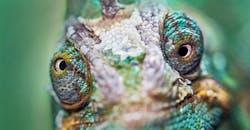Color Changing Today's Applications Through Science
A recent report from the University of California-Riverside researchers Zhiwei Li, Jianbo Jin, Fan Yang, Ningning Song and Yadong Yin announced “the development of programmable mechanochromic films with precise colorimetric responses to a number of mechanical perturbations by preparing magnetic–plasmonic hybrid nanorods through an unconventional colloidal synthesis approach. The plasmonic nanorods are grown alongside the magnetic ones through a seed-mediated process confined within highly permeable polymer shells, producing compact hybrid nanorods with perfect structural alignment, coupled magnetic–plasmonic properties, and excellent colloidal stability.”
What does all of this mean? A new film is available leveraging gold nanoparticles to change color in response to any type of movement. While a number of novel applications will undoubtedly crop up, its intriguing qualities could allow robots to mimic chameleons and octopi — among other futuristic applications.
Yin tells IndustryWeek, at the beginning of commercialization, “anti-counterfeiting, product authentication, and sensors are the easiest areas these films can find broad applications because typically no large area is required,” he says. “These films may also find broad applications in the sports equipment and apparel industries thanks to their unique optical properties in response to various mechanical disturbances.”
Unlike other materials that try to emulate nature’s color changers, this new film has the ability to respond to any type of movement. Although its ability to respond to motion does not completely differentiate it from others on the market, the ability to printed and program the film to display different, complex patterns that are complicated to replicate is a true differentiator. As such, robots coated in it could enter spaces that might be dangerous or impossible for humans, and offer information just based on the way they look.
Other materials, like butterfly wings, are shiny and colorful at certain angles, and can also change color when viewed at other angles. However, those materials rely on precisely ordered microstructures, which are difficult and expensive to make for large areas. But this new film can be made to coat the surface of any sized object just as easily as applying spray paint on a house.
Consider, for example, a camouflaged robot could play a pivotal role in exploration such as entering tough-to-access or unknown environments common in mining or underwater exploration. If the robot changes color, it could provide valuable insights into pressures or environmental abnormalities that could impact further exploration.
According to Yin, material cost is the major challenge in commercialization. “Gold was used as the primary material to create the color. The cost is not a problem if the covered area is relatively small, and it can be further reduced by making the film very thin,” he says. “However, the cost can add up if one wants to cover a really big object, say, for example, a building. We are now trying to replace gold with silver or even copper to reduce the cost and our preliminary results look very promising.”
About the Author
Peter Fretty
Technology Editor
As a highly experienced journalist, Peter Fretty regularly covers advances in manufacturing, information technology, and software. He has written thousands of feature articles, cover stories, and white papers for an assortment of trade journals, business publications, and consumer magazines.
